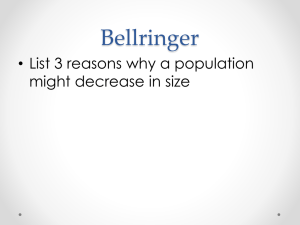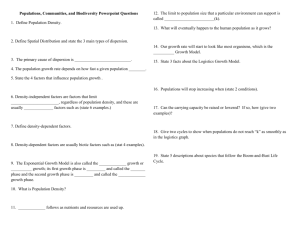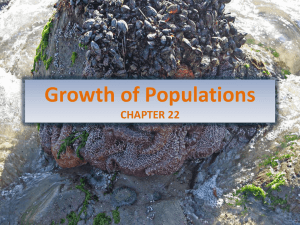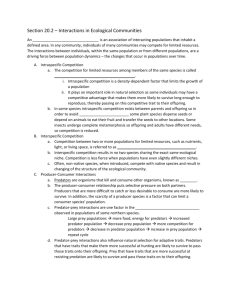Chapters 52 & 53 Population and Community Ecology
advertisement
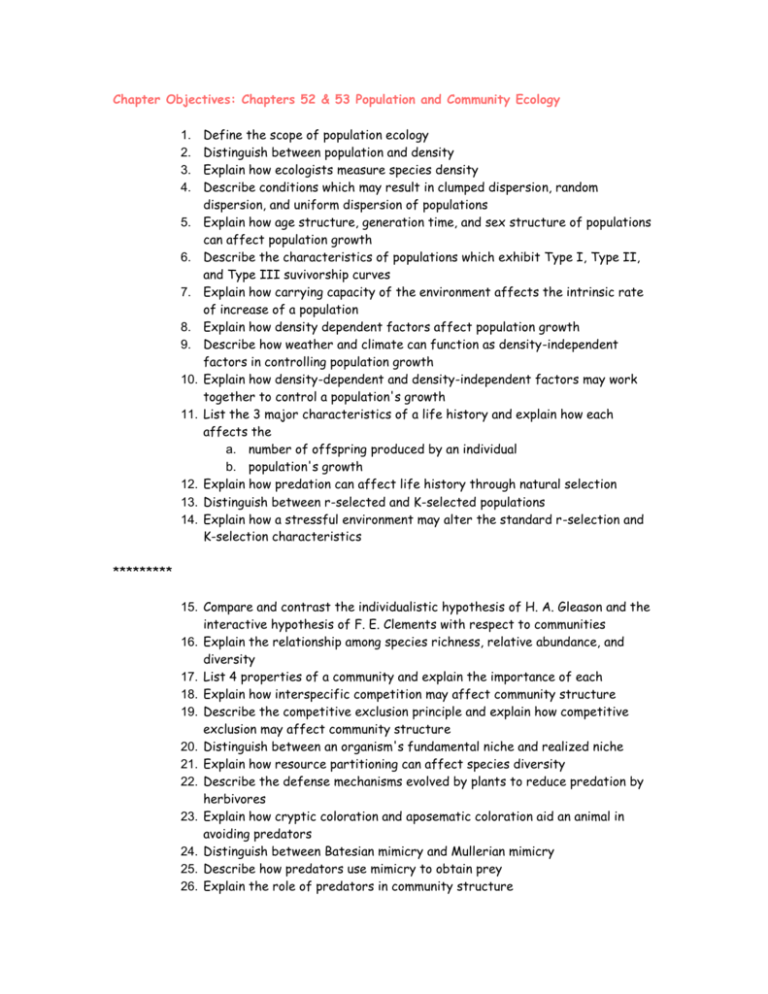
Chapter Objectives: Chapters 52 & 53 Population and Community Ecology 1. 2. 3. 4. 5. 6. 7. 8. 9. 10. 11. 12. 13. 14. Define the scope of population ecology Distinguish between population and density Explain how ecologists measure species density Describe conditions which may result in clumped dispersion, random dispersion, and uniform dispersion of populations Explain how age structure, generation time, and sex structure of populations can affect population growth Describe the characteristics of populations which exhibit Type I, Type II, and Type III suvivorship curves Explain how carrying capacity of the environment affects the intrinsic rate of increase of a population Explain how density dependent factors affect population growth Describe how weather and climate can function as density-independent factors in controlling population growth Explain how density-dependent and density-independent factors may work together to control a population's growth List the 3 major characteristics of a life history and explain how each affects the a. number of offspring produced by an individual b. population's growth Explain how predation can affect life history through natural selection Distinguish between r-selected and K-selected populations Explain how a stressful environment may alter the standard r-selection and K-selection characteristics ********* 15. Compare and contrast the individualistic hypothesis of H. A. Gleason and the interactive hypothesis of F. E. Clements with respect to communities 16. Explain the relationship among species richness, relative abundance, and diversity 17. List 4 properties of a community and explain the importance of each 18. Explain how interspecific competition may affect community structure 19. Describe the competitive exclusion principle and explain how competitive exclusion may affect community structure 20. Distinguish between an organism's fundamental niche and realized niche 21. Explain how resource partitioning can affect species diversity 22. Describe the defense mechanisms evolved by plants to reduce predation by herbivores 23. Explain how cryptic coloration and aposematic coloration aid an animal in avoiding predators 24. Distinguish between Batesian mimicry and Mullerian mimicry 25. Describe how predators use mimicry to obtain prey 26. Explain the role of predators in community structure 27. Distinguish among parasitism, mutualism, and commensalism 28. Explain why it is difficult to determine what factor is most important in structuring a community 29. Distinguish between primary succession and secondary succession 30. Explain how inhibition and facilitation may be involved in succession 31. Describe how natural and human disturbances can affect equilibrium and species diversity 32. List the factors involved in limiting a species to a particular range 33. Describe the mechanisms which contribute to the global clines in diversity 34. Explain the factors which determine what species eventually inhabit islands Chapter Terms: Chapter 52 Terms population fecundity density death rate exponential population growth carrying capacity dispersion generation time logistic population growth mark-recapture method sex ratio K-selected populations clumped life table equilibrial populations random survivorship curve r-selected populations uniform life history opportunistic populations biogeography semelparity intraspecific competition demography iteroparity density-dependent factor age structure zero population growth density-independent factor birth rate intrinsic rate of increase cohort Chapter 53 Terms species richness mimicry resource partitioning relative abundance predator character displacement species diversity Batesian mimicry symbiosis predation Mullerian mimicry symbiont individualistic hypothesis parasite commensalism interactive hypothesis hosts mutualism secondary succession endoparasites keystone species interspecific interactions ectoparasites exotic species coevolution interspecific competition stability parasitism interference competition disturbances parasitoidism exploitative competition ecological succession herbivory competitive exclusion principle primary succession community recruitment ecological niche biogeography fundamental niche dynamic equilibrium hypothesis cryptic coloration prey aposematic coloration intermediate disturbance hypothesis realized niche Chapter Outline Framework A. Characteristics of Populations 1. Density 2. Individual spacing 3. Demography is the study of factors that affect population growth and decline B. Life History Traits 1. Life histories are highly diverse by exhibit patterns in their variability C. D. E. F. G. H. I. J. 2. Limited resources mandate trade-offs between investments in reproduction and survival Population Growth Models 1. Experimental models describe idealized populations in unlimited environments 2. Logistic growth model considers carrying capacity Regulation of Population Growth 1. Density-dependent factors regulate population growth by varying with density 2. Occurrence and severity of density-independent factors are unrelated to population density 3. Mix of density-dependent and density-independent factors limits growth of most populations 4. Some populations have regular boom and bust cycles Human Population Growth 1. Growing exponentially for centuries but will not be able to do so indefinitely Early Hypotheses of Community Structure 1. Interactive and individualistic hypothesis pose alternative explanations of community structure Interactions Between Populations of Different Species 1. Intraspecitic interactions can be strong selection factors in evolution 2. Interspecific interactions may have positive, negative, or neutral effects on population density 3. Predation and parasitism are +/- interactions 4. Interspeciffic competitions are -/- interactions 5. Commensalism is a +/0 interaction 6. Mutualism is a +/+ interaction Interspecific Interactions and Community Structure 1. Predators can alter community structure by moderating competition among prey species 2. Mutualism and parasitism can have community-wide effects 3. Interspecific competition influences populations of many species and can affect community structure 4. A complex interplay of interspecific interactions and environmental variability characterizes community structure Disturbance and Nonequilibrium 1. Nonequilibrium resulting from disturbance is a prominent feature of most communities 2. Humans are the most widespread agents of disturbance 3. Succession is a process of change that results from disturbance in a community 4. The nonequilibrial model views communities as mosaics of patches at different stages of succession Community Ecology and Biogeography 1. Dispersal and survivability in ecological and evolutionary time account for the geographical ranges of species 2. Species diversity on islands tends to reach dynamic equilibrium in ecological time

